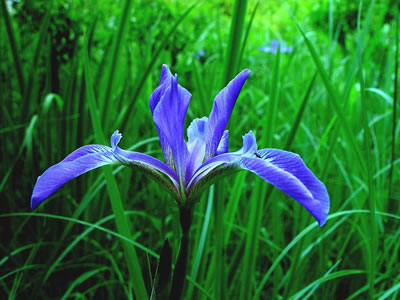Our Native Irises: Blue Flag Irises
Iris versicolor: Harlequin Blue Flag Iris
The harlequin blue flag iris occurs from Newfoundland to Manitoba south to Minnesota and Virginia.
 Note how the style arms of this Iris versicolor arch over the lower portion of the sepal. In this image, the ant is a probable nectar robber and not a potential pollinator. Photo by Charles and Diane Peirce, Michigan Wildflowers.
Note how the style arms of this Iris versicolor arch over the lower portion of the sepal. In this image, the ant is a probable nectar robber and not a potential pollinator. Photo by Charles and Diane Peirce, Michigan Wildflowers.
Iris versicolor has a deep blue to purple, rarely white flower. The spreading sepals have purple veins as they gradually narrow to a white base, with a pubescent, greenish yellow signal. Northern blue flag iris flowers in late spring on a compact two to four flowered inflorescence. The bluish-green leaves are wide arching, up to four feet long and arise from shallowly rooted, large, branching rhizomes forming clumps.
Iris versicolor is commonly found growing on lake shores, swamps, and wet meadows occasionally in shallow water.
 As you look into the back of the style arm, notice the partially observable anthers. The prominent veining and yellow signal serve as the nectar guides. Photo by Charles and Diane Peirce, Michigan Wildflowers.
As you look into the back of the style arm, notice the partially observable anthers. The prominent veining and yellow signal serve as the nectar guides. Photo by Charles and Diane Peirce, Michigan Wildflowers.
 A stately view of Iris versicolor. Photo by Charles and Diane Peirce, Michigan Wildflowers.
A stately view of Iris versicolor. Photo by Charles and Diane Peirce, Michigan Wildflowers.
Conservation Concern
Iris pseudoacorus is an invasive, naturalized, large and vigorous garden escape that is replacing Iris versicolor in some locations.


